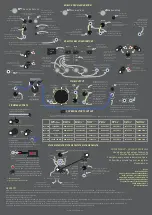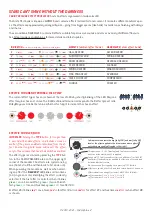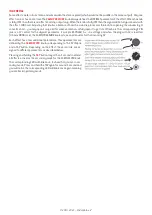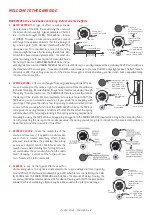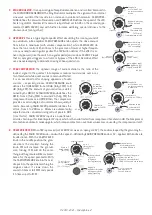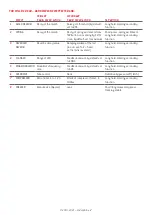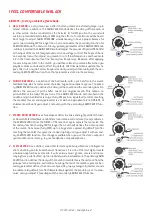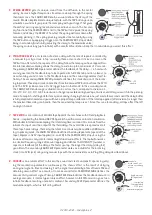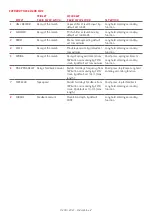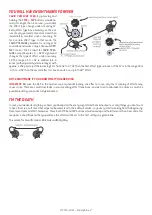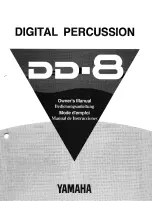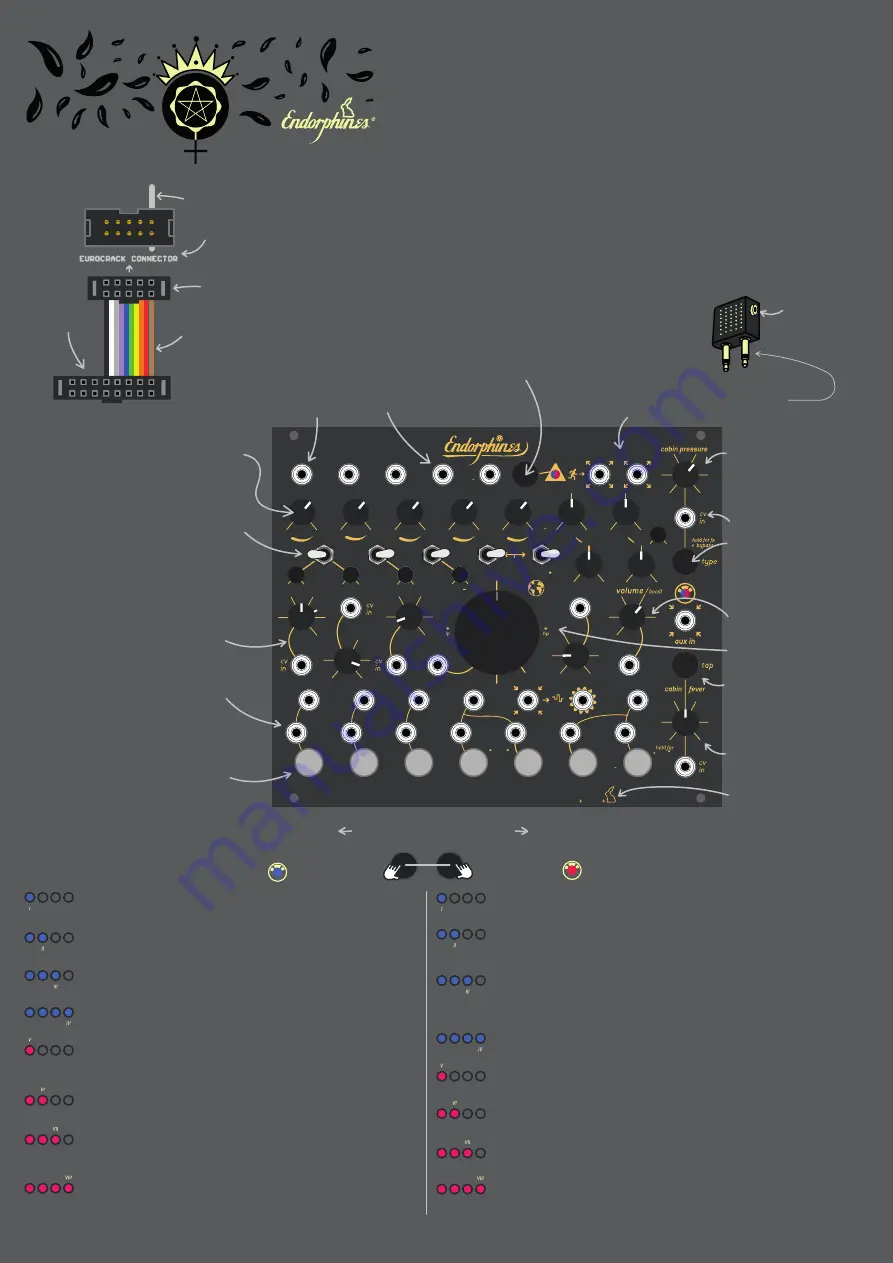
bd tail
flaps
drive
tune
sd/cp tail
throttle
off fx on
mute
spoiler
tune
reso
cv in
tone
sd
bd
cp
s1
ch
s4
cy
0...+5v
rolls
trig
in
trig
in
trig
in
trig
in
trig
in
trig
in
trig
in
hh
choke
ac-
cent
ac-
cent
velo-
city
clock
in
*
s2
oh
s3
rd
vca
cv in
vcf cv in
velo-
city
bd
bd
sd
sd
s1/2
hh
s1/2
hh
s1
s2
s3
s4
cp
cp
aux in
level
s1– s4
mode/bank
out 2
out 1
audio
s3/4
rd/cy
s3/4
rd/cy
ac-
cent
Q
UEEN
O
F
P
ENTACLES
sd card
Separate drum outputs.
Samples 1/2 and 3/4 are grouped outputs.
Plugging a cable into certain outputs will
remove that channel from the final mix.
Audio levels of channels
Enable/mute switches for separate outputs.
Turning the switch to the left disables the effect
and engages the effect when switched to the right
In the middle position the channel is muted.
Switches only affect the sound
of the final outputs: out 1 and out 2
Separate left and right mono final outputs.
You can use airline adapter from the store
to connect headphones directly.
Button for changing the mode for s1–s4 knobs:
envelope decay (blue) or pitch (red)
Long 2 second press
changes the bank
from 1 to 8
WELCOME TO THE CLUB
• 7 voice hybrid drum kit: analogue based: bass drum, snare drum and hand clap
+ 4 sample based drums (e.g. hi-hats, ride and crash cymbal – fully user replaceable)
• Zero-latency sample playback directly from SD card
• Hybrid analog sound generation: 3x band-limited LSRF binary noise generators
with spectrum animation, injected into discrete analog circuits
• On-board effect processor with 2 banks consisting of 16 effects in total,
including additional auxiliary input and firmware update over audio
• Master isolator-style LP/HP filter with with VCA control and saturator booster
• Drums that make you dance: fits all styles of music – specifically tuned for EDM and Techno
• Factory sample bank soundset by Nicolas Bougaïeff (Mute, Novamute)
also including custom sampled Paiste 602 cymbals
Depth: 26,5 mm / 1" (with plugged ribbon cable)
Power requirements: +12V: 350 mA, -12V: 90 mA
red/brown pair or wires correspond
to negative -12V power connector
connect to the
power buss board
POWER CONNECTION
right side of the module
connect to the module
from the right side
-12V / red/brown stripe
polarity marking
Analog drum modifiers for
• BD: drive, tune decay, tail decay
• SD: tune and tail decay
• CP: tone and tail decay merged with the SD
• Spoiler adajuts noise samplerate for each
of the 3 analog drums BD/SD/CP
Individual trigger inputs for each of the drums
as well as accent/velocity CV inputs
Manual launch buttons:
In case there is a clock signal applied to the
CLOCK IN* jack, the buttons trigger
rolls that follow the clock
spot under the faceplate where
the microSD card is inserted
Final manual volume control
with saturator boost after 2 o'clock
Bipolar master lp/hp
zero-delay feedback
state variable filter
CABIN PRESSURE
adjusts the dry (fully CCW) and
wet (fully CW) level or the effect
CABIN FEVER adjusts secondary
effect parameter: decay of the reverb,
feedback of the delay etc.
Manual cabin pressure and fever
knobs act as attenuators when the
cable with CV is inserted
All CV inputs range: 0...+5V
Pressing the TYPE button shortly
cycles thru 8 effect types
•
fx 1,
••
fx 2,
•••
fx 3,
••••
fx 4,
•
fx 5,
••
fx 6,
•••
fx 7,
••••
fx 8
see FX addendum
type
type
+
Short both buttons press changes the bank:
red blink on change indicates Darkwaves bank
blue blink on change indicates Airways bank
•
HALL REVERB:
‘Cabin fever’ knob defines the decay of the reverb or hall size. Holding ‘tap’
for longer than 1 second enables the secondary function for ‘cabin fever’: fixed hi-pass
filter to cut off low frequencies and have more ‘air’ in the final output.
•
SHIMMER REVERB
is a variation of the hall reverb with a pitch shifter to create choir-like,
huge and unrealistic spaces. The primary ‘cabin fever’ function defines the decay and the
secondary function defines the amount of pitch-shifter mixed into original reverb.
•
STEREO ROOM REVERB
recreates a sort of stereo room ambience. Primary ‘cabin fever’ parameter
defines room size and the secondary defines the stereo spread of the reverb, from mono up to a
huge stereo spread.
•
PLATE REVERB.
The primary ‘cabin fever’ defines the decay of the reverb. In real life equivalent
this is the distance from the pickups to the metal plate which is how long the tail of the reverb is
present. Secondary parameter defines the amount of pre-delay to distant sounds in ambience.
AIRWAYS BANK
DARKWAVES BANK
•
GATED REVERB
is based around plate reverb with noise gate. The primary ‘cabin fever’ defines
the reverb decay, but the secondary defines the threshold of the noise gate.
Noise gate’s attack and decay are fixed and chosen experimentally to fit most musical styles.
•
SPRING REVERB:
The primary ‘cabin fever’ defines the decay of the reverb. With the ‘tap’ button
you can simulate a sound as if you pluck the real spring with your finger. The secondary function
is tied to the ‘tap’ button’s ‘pluck the spring’ feature and defines the DECAY of how fast the spring
will calm down after manually plucking it.
•
REVERSED REVERB
takes the reverb tail of the sound and reverses it. If applied on drums like
snare then it creates a breathing effect. ‘Cabin pressure’ knob defines the predelay time and acts
as dry/wet control. 'Cabin fever' sets the reverb decay value. Holding ‘tap’ for longer than
1 second enables the secondary function for ‘cabin fever’: damping, i.e. volume of the tail
(in our case tail = 'head' as the tail is reversed).
•
FLANGER:
The ‘cabin pressure’ knob sets the amount of delay. With primary ‘cabin fever’ we set
the LFO speed. The secondary defines the feedback. Playing with that three parameters allows
to achieve sweeping, airplane engine alike sound with a pretty wide range.
•
RING MODULATOR
multiplies the signal with an internal sine wave oscillator. ‘Cabin pressure’ defines the
amount of modulation and ‘cabin fever’ defines the speed of the oscillator. Secret ingredient – feedback!
Its amount is controlled by the secondary ‘cabin fever’ and brings special dirtiness to the sounds.
•
OVERDRIVE:
‘Cabin pressure’ knob adjusts the drive amount with volume compensation, while ‘cabin fever’
defines the tone control as usually found in guitar pedals. The ‘tap’ button makes the effect active or
bypassed, like the switch on a guitar pedal – and so does ‘cabin fever’ latching trigger CV input.
•
PEAK COMPRESSOR:
‘Cabin pressure’ knob defines the threshold from -90dB to 0dB (fully CW). Primary
‘cabin fever’ sets the amount of gain reduction (ratio) from 1 to 25. Secondary parameter defines the
attack, from 1 to 200 msec. Release is always ‘auto’. ‘C. fever’ CV input is an unattenuated side-chain input.
•
FREEZER/LOOPER:
When ‘tap’ is pressed (or ‘cabin fever’ CV gate is ON), the audio is looped by the grain
length defined by the ‘cabin fever’ knob – and with the speed – defined by ‘cabin pressure’ knob or
CV – applied.
•
SPRING REVERB.
The primary ‘cabin fever’ defines the decay of the reverb. With the ‘tap’ button
you can simulate a sound as if you pluck the real spring with your finger. The secondary function
is tied to the ‘tap’ button’s ‘pluck the spring’ feature and defines the decay of how fast the spring
will calm down after manually plucking it.
•
PING-PONG DELAY
is a stereo clocked delay. A ‘tap’ is usually three or more short clicks on the
‘tap’ button. The primary ‘cabin fever’ parameter defines the feedback of the delay or repeats.
The secondary defines the clock division of the incoming tap/clock: 1, 3/4, 2/3, 1/2, 1/3, 1/4, 1/8
•
TAPE ECHO
is a delay with 3 fixed playback heads. Primary ‘cabin fever’ parameter defines the
delay repeat rate which is the speed of tape. The ‘tap’ button works in a limited frequency range
of manual tapping and defines the amount of feedback. The secondary works as a divider for
the incoming clock.
•
CHORUS:
Primary ‘cabin fever’ knob defines the feedback amount. In average amounts, it creates
typical unison effect however in full CW it goes to an infinite feedback resulting unrealistic
ambient. Secondary parameter defines the modulation depth, which is 'full on' by default.
separate left and rigth
3.5mm TS inputs/outputs
stereo TRS 3.5mm
input/output
LINK:
https://endorphines.myshopify.com/collections/all-products/
products/airplane-audio-adapter-stereo-into-l-r-mono
© 2010–2021 Endorphin.es®
Long press of both buttons resets the effect parameters
Q
UEEN
O
F
P
ENTACLES
Holding TAP button for longer than 1 sec.
enters secondary effect setting
(depeding on the effect type)


